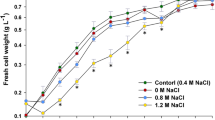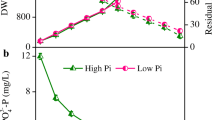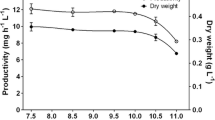Abstract
β-N-Methylamino-l-alanine (BMAA), a non-proteinogenic amino acid, has been detected in a range of cyanobacteria, including terrestrial, aquatic, free living and endosymbiotic species. The widespread occurrence of cyanobacteria in the environment raises concerns regarding the ecological and toxicological impact of BMAA, and consequently, studies have focussed extensively on the toxicity and environmental impact of BMAA, while no research has addressed the ecophysiological or metabolic role of the compound in cyanobacteria. In this study, both the uptake of exogenous BMAA by and the effect of exogenous BMAA on the growth of Synechocystis PCC6803 were investigated. BMAA was rapidly taken up by the non-diazotrophic cyanobacterium Synechocystis PCC6803 in a concentration dependent manner. The presence of exogenous BMAA resulted in a substantial and concentration-dependent decrease in cell growth and the substantial loss of photosynthetic pigmentation. Similar effects were seen in the presence of the non-proteinogenic amino acid, 2,4-diaminobutyric acid but to a lesser degree than that of BMAA. The effects were reversed when light was decreased from 16 to 10 μmol m−2 s−1. Control cultures grown in the presence of l-arginine, l-asparagine, l-glutamate and glycine showed normal or slightly increased growth with no change in pigmentation. The decrease in growth rate coupled to bleaching indicates that BMAA may induce chlorosis in the presence of adequate photosynthetic radiation suggesting a connection between BMAA and the induction of conditions, such as nitrogen or sulphur depletion, that result in growth arrest and the induction of chlorosis.







Similar content being viewed by others
References
Anderson SL, McIntosh L (1991) Light-activated heterotrophic growth of the cyanobacterium Synechocystis sp. PCC6803: a blue-light-requiring process. J Bacteriol 173(9):2761–2767
Banack SA, Johnson HE, Cheng R, Cox PA (2007) Production of neurotoxic BMAA by marine cyanobacteria. Mar Drugs 5:180–196
Banack SA, Downing TG, Spacil Z, Purdie EL, Metcalf JS, Downing S, Esterhuizen M, Codd GA, Cox PA (2010) Distinguishing the cyanobacterial neurotoxin β-N-methylamino-L-alanine (BMAA) from its structural isomer 2,4-diaminobutyric acid (2,4-DAB). Toxicon 56(6):868–879
Brenner ED, Martinez-Barboza N, Clark AP, Liang QS, Stevenson DW, Coruzzi GM (2000) Arabidopsis mutants resistant to S(+)-b-methyl-a, b-diaminopropionic acid, a cycad-derived glutamate receptor agonist. Plant Physiol 124:1615–1624
Cox PA, Banack SA, Murch SJ (2003) Biomagnification of cyanobacterial neurotoxins and neurodegenerative disease among the Chamorro people of Guam. Proc Natl Acad Sci USA 100:13380–13383
Cox PA, Banack SA, Murch SJ, Rasmussen U, Tien G, Bidigare RR, Metcalf JS, Morrison LF, Codd GA, Bergman B (2005) Diverse taxa of cyanobacteria produce β-N-methylamino-L-alanine, a neurotoxic amino acid. Proc Natl Acad Sci USA 102:5074–5078
Esterhuizen M, Downing TG (2008) β-N-Methylamino-L-alanine (BMAA) in novel South African cyanobacterial isolates. Ecotoxicol Environ Saf 71:309–313
Esterhuizen M, Pflugmacher S, Downing TG (2011) β-N-Methylamino-L-alanine (BMAA) uptake by the aquatic macrophyte Ceratophyllum demersum. Ecotoxicol Environ Saf 74(1):74–77
Esterhuizen M, Downing S, Downing TG (2011) Improved sensitivity using liquid chromatography mass spectrometry (LC-MS) for detection of propyl chloroformate derivatised β-N-methylamino-L-alanine (BMAA) in cyanobacteria. Water SA 37(2):133–138
Flores E, Herrero A (1994) Assimilatory nitrogen metabolism and its regulation. In: Bryant DA (ed) The molecular biology of cyanobacteria. Kluwer Academic, Dordrecht, pp 487–517
Kurland LT (1972) An appraisal of the neurotoxicity of cycad and the etiology of amyotrophic lateral sclerosis on Guam. Fed Proc 31:1540–1542
Montesinos ML, Herrero A, Flores E (1995) Amino acid transport systems required for diazotrophic growth in the cyanobacterium Anabaena sp. strain PCC7120. J Bacteriol 177(11):3150–3157
Rippka R (1988) Isolation and purification of cyanobacteria. Methods Enzymol 167:3–27
Ping X, McAuley PJ (1990) Uptake of amino acids by the cyanobacterium Anabaena ATCC 27893. New Phytol 115:581–585
Sauer J, Schreiber U, Schmid R, Völker U, Forchhammer K (2001) Nitrogen starvation-induced chlorosis in Synechococcus PCC 7942. Low-level photosynthesis as a mechanism of long-term survival. Plant Physiol 126:233–243
Schwarz R, Forchhammer K (2005) Acclimation of unicellular cyanobacteria to macronutrient deficiency: emergence of a complex network of cellular responses. Microbiol 151:2503–2514
Spencer PS, Nunn PB, Hugon J, Ludolph AC, Ross SM, Roy DN, Robertson RC (1987) Guam amyotrophic lateral sclerosis–parkinsonism–dementia linked to a plant excitant neurotoxin. Science 237(4814):517–522
Weathers PJ, Chee HL, Allen MM (1978) Arginine catabolism in Aphanocapsa 6308. Arch Microbiol 118:1–6
Acknowledgements
This research was funded by the Water Research Commission of South Africa project K5/1885.
Author information
Authors and Affiliations
Corresponding author
Rights and permissions
About this article
Cite this article
Downing, S., van de Venter, M. & Downing, T.G. The Effect of Exogenous β-N-Methylamino-l-alanine on the Growth of Synechocystis PCC6803. Microb Ecol 63, 149–156 (2012). https://doi.org/10.1007/s00248-011-9958-9
Received:
Accepted:
Published:
Issue Date:
DOI: https://doi.org/10.1007/s00248-011-9958-9




